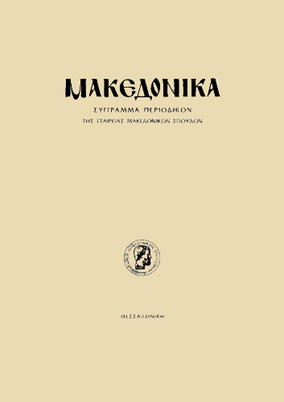Ανασκαφή νεολιθικού οικισμού Θέρμης Β και βυζαντινής εγκατάστασης παρά τον προϊστορικό οικισμό Θέρμη : Α. Ανασκαφική περίοδος 1989
Part of : Μακεδονικά ; Vol.28, 1992, pages 381-501
Issue:
Pages:
381-501
Parallel Title:
Excavation at the Neolithic settlement Thermi B and the Byzantine habitation by the prehistoric settlement Thermi : A. Excavational season 1989.
Section Title:
Articles
Author:
- Γραμμένος, Δημήτριος Β.
- Παππά, Μαρία
- Urem-Kotsou, Dusanca
- Σκουρτοπούλου, Κατερίνα
- Γιαννούλη, Ευτ., Γ.
- Μαραγκού, Χριστίνα
- Βαλαμώτη, Σουλτάνα Μαρία
- Συρίδης, Γ.
- Μαρκή, Ευτέρπη
- Χρηστίδου, Ροζαλία
- Γραμμένος, Δ. Β.
- Παππά, Μαρία
- Urem-Κώτσου, Dusanca
- Σκουρτοπούλου, Κατερίνα
- Γιαννούλη, Ευτυχία
- Μαραγκού, Χριστίνα
- Βαλαμώτη, Σ. Μ.
- Συρίδης, Γεώργιος
- Μαρκή, Ε.
- Χρηστίδου, Ροζαλία
Abstract:
After an interval of one year, the excavation of the Neolithic flat-extended settlement Thermi B was continued in 1989. Research was also carried out at the Byzantine habitation on the eastern slope of the mound Thermi A. The preliminary results of the excavation of 1989 and short reports of the study of the material are presented in this paper.D. Grammenos presents the overall results of the excavation: The size of the settlement proved to be smaller than the first suggestions. The archaeological layers are three meters deep. The discovery of the extended stone pavements in the deepest layer, which have been interpreted as open workshops, is the most important architectural evidence. Finally, this new site is related to the data of the excavation at Thermi A, carried out by Rey.M. Pappa presents the aims and method of the excavation of 1989 and describes the excavational trenches. The stratigraphic evidence of 1987 is attested, while the three main phases of excavational layers are preserved : a) Phase T: surface, b) Phase II: grey layers with sparse habitation evidence, c) Phase III: habitation layers (Ilia: rooms, Illb: stone pavements). Finally the new data refering to the space organization according to the trenches and phases are also described,D. Urem-Kotsou studied the pottery and devided it in to categories. She suggests that the pottery belongs to the Dimeni phases. The pottery distribution to layers does not present great variations.K. Skourtopoulou examined the raw material of the stone implements and the process of the lithic production. The use of chert and quartz, abundant in the area, implies a local production, while no specialized factors are traced. The small quantity of imported material suggests the lack of systematic participation of the settlement in an intrasite exchange network.E. Giannouli studied the animal bones and presents the preliminary results and statistic data. The species identified are: goat, sheep, domestic cow, wild bear, dog, red deer, fallow deer and badger. She suggests the existence of evidence for bone partial distribution to the trenches of the excavation. A preliminary study, of the carbonised plant remains recovered from the site, is presented by S.-M. Vaiamoti. The species identified are: einkorn, emmer and bread/durum wheat, hulled barley, legumes, grape, blackberry and wild pistacio. A range of wild species has only been partly identified. The study provides some evidence on cereal processing and the use of the respective by-products. This evidence also implies that einkorn and emmerwere consumed as food by the inhabitants of the site.Ch. Marangou studied the figurines discovered during the two excavational seasons. Sixteen figurines were only found most of them were anthro pomorphic. Phase Illb yielded three further categories of figurines: two zoo- morphic, one vessel and four models. The categories, the manufacture and the use of tne figurines are examined, while a catalogue is also included.A comparative study of the molluscs from Thermi B and Basilica C is presented by G. Syrides. The molluscs were mainly used as food. They must have been collected from the nearby shore of the western side of the basin of Anthemous.E. Marki studied the finds of the Byzantine habitation which was located near Thermi A. It is probably a manor related to the Byzantine village Sedes. The pottery suggests that it was built in the 12th and was used in the12th and 13th centuries A.D.Finally, R. Chrestidou presents the preliminary examination of the bonetool industry. The study of the samples does not suggest activity differentiation referring to the bone-tool industry in the three phases of the settlement; however the frequency of implements is higher on the stone pavements. It is significant to mention that the excavated tools are all worn out.
Subject:
Subject (LC):
Notes:
856:https://ejournals.epublishing.ekt.gr/index.php/makedonika/article/view/5718, DOI: https://doi.org/10.12681/makedonika.157
Electronic Resources:




